If you want to build a bigger and stronger rear delt, you should add bent-over lateral raises to your shoulder workout routine.
Why are bent-over lateral raises so vital? They are the best exercise for targeting your upper back and shoulder muscles, particularly the posterior deltoids, or rear deltoids, on the backside of your shoulders.
It helps you to hone in on the small muscles of the rear delt by using a full range of motion that will explore the growth of your shoulder muscles.
In this beginner guide, we will explore the following:
- What is Bent Over Lateral Raise?
- Bent Over Lateral Raise Muscles Worked
- How To Do Bent Over Dumbbell Lateral Raise
- Proper Form & Technique
- Best variations

- What is Bent Over Lateral Raise?
- Bent Over Lateral Raise Muscles Worked
- How To Do Bent Over Dumbbell Lateral Raise
- Bent Over Lateral Raise Proper Form & Technique
- 1. Maintain a neutral spine
- 2. Bend at the waist
- 3. Activate your core
- 4. Control the weight
- 5. Use an appropriate weight
- 6. Do a full range of motion
- 7. Allow Rest and Recovery
- Best variations of Bent over lateral raise
- 1. Seated Dumbbell Bent over lateral raise
- 2. One Arm Dumbbell Bent over lateral raise
- 3. Bent over Cable Bent over lateral raise
- 4. Cable Seated Bent Over Lateral Raise
- 5. Head-supported Bent Over Lateral Raise
- 6. One-Arm Bent-Over Cable Lateral Raise
- 7. Barbell Rear Delt Raise
- Best Alternate of Bent Over Lateral Raise
- 1. Lying Dumbbell Rear Delt Row
- 2. Standing Barbell Rear Delt Row
- 3. Face Pull
- 4. Incline Dumbbell Y-Raise
- Benefits of Bent-Over Lateral Raise
- FAQs
- What muscles do bent-over lateral raises work?
- Can I perform Bent Over Lateral Raises with resistance bands instead of dumbbells?
- What is the difference between a lateral raise and a bent-over raise?
- Are bent-over lateral raises good?
- Takeaways
- 12 Best Rear Delt Exercises for Mass and Strength
What is Bent Over Lateral Raise?
The bent-over lateral raise, also known as the bent-over rear delt raise, is an isolation exercise that primarily targets the rear deltoids. It is a must-do for complete shoulder muscle development.
While many shoulder exercises like overhead presses and lateral raises work the front and side delts, the bent-over raise emphasizes the rear deltoids. It helps you build strength, stability, and size in your shoulders.
Strengthening the rear delts by using the bent-over rear delt fly can improve posture and increase strength on other lifts.
There are many variations of bent-over lateral raise that you can add to your workout routine. Each has unique benefits.
- Dumbbell Bent Over Raise: Enhances shoulder stability with free weights.
- Cable Rear Delt Lateral Raise: Constant tension for efficient muscle activation.
- Incline Bench Rear Raise: Increases stretch and contraction for rear delt development.
- One-Arm Rear Bent Over Raise: Improves symmetry and targets rear deltoid isolation.
- Resistance Bands Bent Over Raise: Portable option for rear delt training.

Bent Over Lateral Raise Muscles Worked
The bent-over rear lateral raise primarily works the rear delt and a handful of other muscles that work or play the role of stabilizer muscles, including the Lateral deltoid, trapezius, rhomboids, infraspinatus, teres minor, and teres major.
The standing bent over rear delt raise involves several synergist muscles, including oblique and core muscles.

How To Do Bent Over Dumbbell Lateral Raise
- Stand with your feet shoulder-width apart and a slight bend in your knees.
- Hold a dumbbell in each hand with a neutral grip (palms facing each other).
- Hinge at your hips while maintaining a straight back and slightly bend forward.
- Your upper body should be almost parallel to the floor.
- Keep your head neutral, looking down towards the floor to maintain a straight spine.
- Engage your core to stabilize your body throughout the movement.
- With a slight bend in your elbows, raise both arms out to the sides in a controlled motion.
- Keep raising your arms until they align with your shoulders, forming a “T” shape with your body.
- At the top of the movement, squeeze your shoulder blades together to engage the rear deltoids fully.
- Pause briefly at the top of the motion to maximize the contraction in your rear deltoids.
- Slowly lower the dumbbells back to the starting position in a controlled manner.
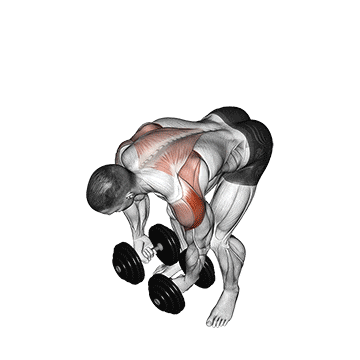
Bent Over Lateral Raise Proper Form & Technique
To make the bent-over lateral raise as effective as possible, it’s important to maintain good form and technique throughout.
Follow these guidelines to ensure you’re performing the exercise correctly:
1. Maintain a neutral spine
Keep your back straight and avoid rounding or arching it. This will help protect your lower back and effectively engage the targeted muscles.
2. Bend at the waist
You should hinge at the waist and lower your torso until it is parallel to the ground. This position allows for optimal rear deltoid activation and prevents excessive stress on the lower back.
3. Activate your core
To activate your core muscles, draw your belly button towards your spine. This will help to keep your back straight and provide stability throughout the exercise.
4. Control the weight
Avoid using momentum or swinging your body to lift the dumbbells. Maintain a slow and controlled movement.
5. Use an appropriate weight
Start with lighter weights and gradually increase the load as you become more comfortable with the exercise. Using too heavy weights can worsen your form and increase the risk of getting hurt.
6. Do a full range of motion
Lifting the dumbbells to the sides of your body is important to get a full range of motion. Avoid stopping halfway or not fully extending the arms, as this limits the engagement of the rear deltoids.
7. Allow Rest and Recovery
Rest for 24 to 48 hours before training the same muscle groups to allow sufficient recovery.
Best variations of Bent over lateral raise
Incorporating different variations of the bent-over lateral raises exercise can be beneficial.
- Firstly, changing the angle of the movement or the type of equipment used can activate different muscle fibers in the rear deltoids and prevent plateauing. This can increase strength and muscle growth.
- Secondly, varying your exercise routine can help prevent boredom and keep your workouts interesting and challenging.
- The bent-over lateral raises can be modified to prevent injury by targeting different muscle groups rather than just one.
1. Seated Dumbbell Bent over lateral raise
The bent-over dumbbell lateral raise, also known as the bent-over rear delt fly, is a great exercise for building a complete set of shoulders.
Many lifters utilize the bent-over dumbbell reverse fly to target the rear delts, an often lagging muscle for many lifters alike.
This exercise can be performed in both a standing and a seated position. However, I prefer the seated version, as it requires strict movement.

How To Do
- Sit at the end of a bench with a pair of dumbbells.
- Bend forward and let the dumbbells hang on your sides.
- Lift the dumbbells, raising them on your sides to a level slightly higher than your shoulders.
- Now lower the dumbbells back to your sides.
Tips
- Your arms should be parallel to your shoulders.
- Keep strict form to isolate the rear delts.
Know More: The Ultimate Guide To Dumbbell Rear Delt Workout
2. One Arm Dumbbell Bent over lateral raise
The One-Arm Dumbbell Bent-over Lateral Raise is a unilateral variation of the bent-over lateral raise that targets one side of the posterior deltoid.
Unilateral exercises often demand greater focus and coordination. This allows you to connect with your muscles better, improving muscle activation and engagement.
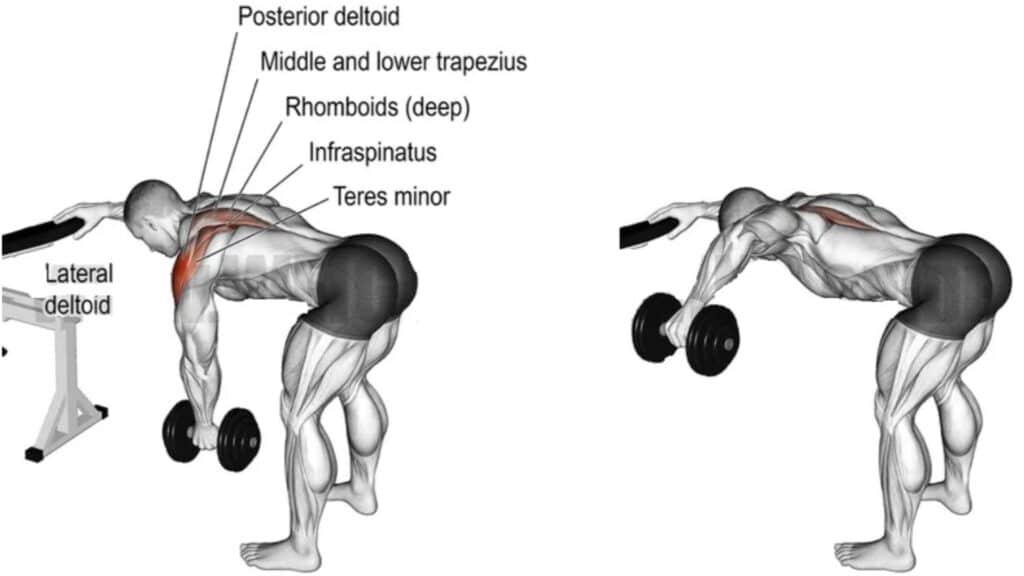
How To Do
- Hold a dumbbell in one hand and bend at the hips and knees until your torso is parallel to the floor.
- For stability, grasp something stable with your free hand.
- The dumbbells should be hanging straight down in front of you, with your palm facing inward (neutral grip)
- Keep your elbow slightly bent and raise the dumbbell to the side until it is leveled with your shoulders.
- Hold for a count of two, and then slowly lower the dumbbells to the starting position.
- Repeat for the desired number of repetitions.
Tips
- Practice good form with a lightweight. Keep strict form to isolate the rear delts.
- Do not swing the dumbbells upward. Keep your back straight and your body still.
- Your arms should be parallel to your shoulders.
3. Bent over Cable Bent over lateral raise
A bent over cable raise is an excellent exercise to train and isolate the rear deltoid muscle. It provides constant stress on the muscles. Unlike dumbbell raises, where the resistance varies during the lift, the cable pulley affords a uniform resistance throughout the motion.
However, there are many bent-over cable lateral raise variations that you can try out, which may require different types of bent-over cable lateral raise equipment.

How To Do
- Grab the handles attached to two low pulleys (left-side handle in right hand, right-side handle in left hand).
- Stand in the middle, then bend forward at the waist with the back straight and parallel to the floor.
- Raise your hands upward in an arc to shoulder level so the cables cross over.
- Lower the handles back down to the start position, your right hand directly in front of the left ankle and your left hand in front of the right ankle.
Tips
- Pull slowly so that you are always controlling the weight.
- Remember to exhale while you exert.
Know More: Rear Delt Cable Exercises For Bigger & Stronger Shoulder
4. Cable Seated Bent Over Lateral Raise
Unlike dumbbell exercises, where tension decreases at the bottom of the movement, the cable machine provides continuous resistance throughout the entire range of motion.
This constant tension maximizes muscle engagement and helps stimulate greater muscle growth.
It also provides smoother and more controlled movements that help isolate and target the rear deltoids effectively.
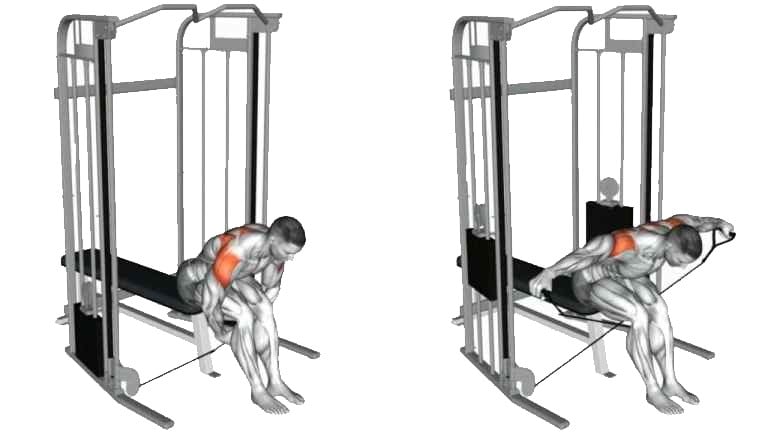
How To Do
- Sit on a bench in the middle of two low pulleys and bend forwards.
- Grasp the left pulley with the right hand and the right pulley with the left. The pulleys should run under the bench.
- Your chest should almost lie on your thighs. Keep your back straight.
- Lift your arms to the sides until your arms get slightly above shoulder level.
- Pause at the top for 1–2 seconds and slowly return to the starting position.
Tips
- Do not swing your torso and keep your back straight.
- Arms should be slightly bent and extend almost straight at the movement’s top.
5. Head-supported Bent Over Lateral Raise
The head-supported reverse dumbbell fly is also known as the head-supported bent-over dumbbell lateral raise.
Keep your torso horizontal during it to target your posterior deltoids. The more upright your torso is, the more emphasis you will place on your lateral deltoids instead of on your posterior deltoids.

How To Do
- Raise a bench to hip height and hold a dumbbell in each hand, bend at the hips, and rest your forehead on the edge of the bench.
- The back should be straight, and your arms should be hanging in front of you, with your palms facing inward (neutral grip).
- Keeping your elbows slightly bent, raise both arms out to the sides until the dumbbells are level with the height of your shoulders.
- Hold for a count of two, and then slowly lower the dumbbells to the starting position.
- Repeat for the desired number of repetitions.
Tips
- Do not swing the dumbbells upward. Keep your back straight and your body still.
- Keep your body still. Only your arms should move.
6. One-Arm Bent-Over Cable Lateral Raise
You can do this exercise using one arm at a time, allowing you to alter the range of motion by adjusting the start or finish position.
This unilateral version makes it possible to raise your hand higher and get a longer stretch at the bottom, thereby generating more work for the posterior deltoid. Stabilize your torso by resting your free hand on your thigh.

How To Do
- Lean forward at the hips, place your right hand on your thigh, and hold a cable pulley in your left hand with your arm extended straight down.
- Raise the weight straight out to the side until your arm is parallel with the floor.
- Pause momentarily at the top of the motion before slowly lowering the weight back down to the starting position.
- Repeat with the right arm.
Tips
- Pull slowly so that you are always controlling the weight.
- Remember to exhale while you exert.
7. Barbell Rear Delt Raise
The barbell rear delt raise is a unique, underrated shoulder exercise that still deserves a place in your workout routine.
It works several muscles of the upper body and is a great option for really loading the muscles that make up the shoulder girdle.
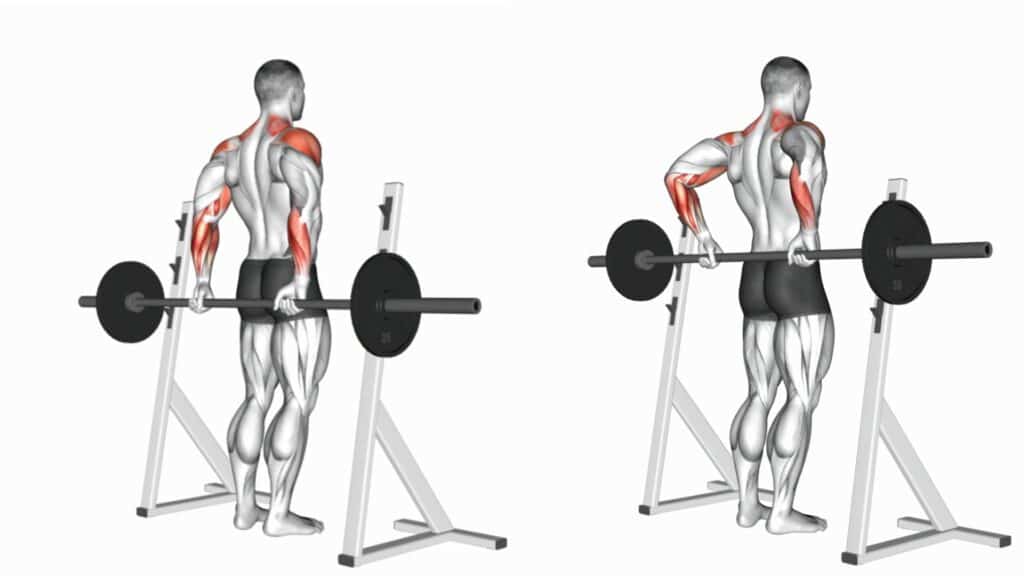
How To Do
- Place the barbell on the floor and stand with your heels touching it, feet about hip or shoulder-width apart.
- Bend down and grip the bar with your hands about hip-width apart, palms facing away from you.
- Stand up straight and let the barbell hang down with arms extended.
- Keep a good posture, and you can bend your knees slightly.
- Use your upper rear muscles to pull your elbows up behind your back. Extend your arms and repeat.
Know More: Barbell Shoulder Exercises To Build Mass And Strength
Best Alternate of Bent Over Lateral Raise
1. Lying Dumbbell Rear Delt Row
Dumbbell Lying Rear Delt Row is a strength exercise that works your deltoids and side deltoids. Dumbbell Lying Rear Delt Row is a great basic move. When done correctly, it can effectively target your shoulders and upper body.
The muscles used for dumbbell-laying rear delt row may change slightly based on your trained range of motion and technique, but in the most general case, the rear deltoid is trained the most.

2. Standing Barbell Rear Delt Row
Standing barbell rear delt row is a free weight exercise that primarily targets the rear deltoid and middle back, and to a lesser degree, it also targets the biceps, shoulders, and traps.
If you haven’t tried this exercise before, load the barbell with a reasonable amount of weight, prioritizing an amount that allows you to stick to proper form rather than trying to lift heavy.

3. Face Pull
Face pull is a cable machine exercise that primarily targets the rear deltoid and, to a lesser degree, the biceps, triceps, and traps. Use a cable pulley machine to pull the weight straight toward your forehead.
This exercise prevents muscular imbalance and builds overall shoulder strength.
However, there are many variations of face pull that you can try, and some may require different types of equipment and setup.

4. Incline Dumbbell Y-Raise
The Incline Dumbbell Y Raise is a great and easy shoulder stability exercise that targets the rear delt, rotator cuff muscles and your traps.
Y raises are commonly performed on an incline bench but can be modified to suit your needs and performed in various ways: standing, on the floor, on a flat or incline bench, or even swish ball.
The exercise enhances upper body strength and posture and can be advantageous for athletes involved in sports that necessitate robust scapular and shoulder stability, such as gymnastics, swimming, and rowing.
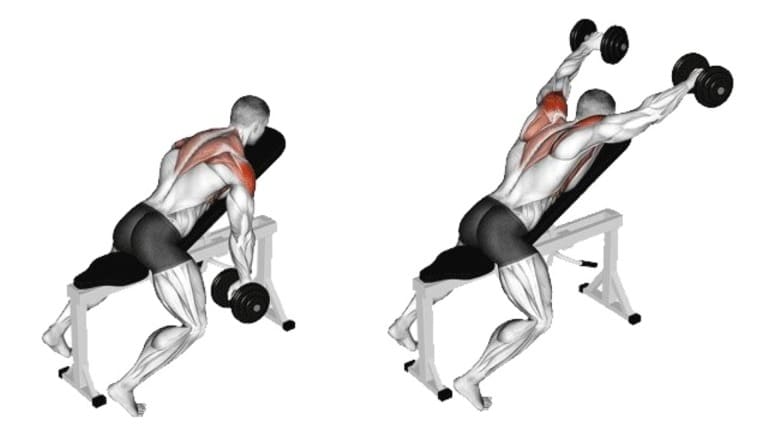
Benefits of Bent-Over Lateral Raise
- It improves rear delt width and definition.
- It helps prevent the shoulders from rounding forward, leading to poor posture.
- Boost shoulder stability and Prevent shoulder injuries
- Build symmetry with the shoulder, preventing a “forward-sloping” look
- Improve shoulder function.
- Help to tone and sculpt the upper back.
- It can be performed with dumbbells, resistance bands, or cables, providing flexibility in workout routines.
FAQs
What muscles do bent-over lateral raises work?
Bent-over lateral raises primarily work the rear deltoids, but they also work the rhomboids, trapezius, and lower back.
Can I perform Bent Over Lateral Raises with resistance bands instead of dumbbells?
Yes, Bent Over Lateral Raises can be performed with resistance bands. Using resistance bands adds variety to your workout and allows you to challenge your muscles differently.
What is the difference between a lateral raise and a bent-over raise?
Lateral Raise primarily targets the lateral deltoids (side shoulders) and helps improve shoulder width and definition, whereas Bent-Over Raise targets the posterior deltoids (rear shoulders) and upper back muscles, contributing to better shoulder stability and posture.
Are bent-over lateral raises good?
Yes, bent-over lateral raises are a good exercise. They effectively target the posterior deltoids, rhomboids, and trapezius muscles, contributing to strong, well-defined shoulders.
Takeaways
Now that you know a few variations for your Bent-Over Lateral Raise, hit the gym and try each one to get the full effect. Don’t limit yourself to variations on this exercise, either.
Seek new and interesting ways to perform all your staple movements so that you never get stuck waiting at the gym, never grow bored, and always keep growing.
12 Best Rear Delt Exercises for Mass and Strength

Manish brings over 10 years of hands-on experience in weight lifting and fat loss to fitness coaching. He specializes in gym-based training and has a lot of knowledge about exercise, lifting technique, biomechanics, and more.
Through “Fit Life Regime,” he generously shares the insights he’s gained over a decade in the field. His goal is to equip others with the knowledge to start their own fitness journey.
